#office for rent in Phnom Penh
Explore tagged Tumblr posts
Link
Get Luxury Apartment in Cambodia at Reasonable Price. We provide high standard and fully furnished apartments with modern appliances.If you want more details then visit our site.
#apartment in cambodia#luxury apartments#office for rent in phnom penh#office space for rent in phnom penh#phnom penh rentals#serviced apartments#shared office space phnom penh#villa for rent in phnom penh#work in cambodia#apartment for rent in phnom penh#sunset apartment phnom penh#Luxury Apartments Phnom Penh#home for rent in phnom penh#apartment for rent in phnom penh cambodia#service apartment for rent in phnom penh#flat for rent in phnom penh
1 note
·
View note
Text
Choose From Best Apartment for Rent Phnom Penh
Rentex Cambodia provides you some of the best apartment for rent Phnom Penh in thriving central business locations. Being the capital of Cambodia and also the industrial, cultural and economic hub, the city has seen huge influx of domestic and foreign professionals. So, there is a huge demand for quality rental apartment. You can search your favorite one from our wide range of apartments. From large and small service apartments to modern high rise condos to stunning colonial apartments; the choice is all yours. Prices are negotiable.
You can phone us at :- 016430555 or can mail us at:- [email protected]
0 notes
Link
They're called "red zones" - Covid hotspots in Cambodia's capital of Phnom Penh that have gone into lockdown. But those living inside say food - and help - is scarce, writes journalist Kiana Duncan.
Somal Ratanak had spent nearly his whole pay cheque when his neighbourhood in Phnom Penh was locked down on 12 April.
The area was eventually designated a red zone - he was left unable to leave his house or go to work as a cashier.
Mr Somal is now unsure of where his next meal might come from.
He had earlier this month received a standard government issued aid package of rice, noodles, soy sauce, and canned fish.
But these deliveries are irregular and Mr Somal cannot count on them, saying he has to "eat a lot less than before".
He's not alone. Harsh new restrictions aimed at controlling a late February outbreak have left tens of thousands trapped in their homes, with food insecurity a real problem.
Despite Cambodia being lauded for its tight Covid-19 restrictions and relatively low case numbers last year, the country is now seeing around 400 new infections a day, and has nearly 20,000 cases and 131 deaths in total.
Hospitals are over capacity, forcing authorities to create temporary hospitals in stadiums and care centres, with some people in need of medical attention told to quarantine at home.
As a means of containing the spread, the government has imposed progressively tighter restrictions on mobility, such as district lockdowns and colour-coded zoning.
Inside the red zone
There are an estimated 120,000 people living in Phnom Penh's red zones, according to the Center for Alliance of Labor and Human Rights (Central).
These red zones are Covid-19 hot spots, sealed off with barricades and strictly monitored by soldiers.
Phnom Penh currently has four such districts with individual sections still in lockdown, which will be retained until 19 May.
Residents in these zones are forced to remain in their homes under threat of arrest, fines or even violence, prompting aid organisations to express concern over human rights abuses.
Rules and regulations vary from officer to officer and inconsistent disciplinary action has left residents without a clear understanding of what to do, with some able to leave for food runs and emergency healthcare and others trapped inside.
The Ministry of Commerce has sent buses doubling as mobile food shops in some neighbourhoods to make up for the mass closure of small shops and markets - but some can barely afford even this basic spread.
Residents living in these zones are seeing prices rise by as much as 20% and their income fall, said Central.
NGOs have also been barred from the red zones - making it even harder to reach those in need.
Amnesty International's Deputy Regional Director for Campaigns Ming Yu Hah says the government's response so far has been haphazard.
The government's aid package for example, have been sporadic - reaching only a fraction of those in the red zones.
These were initially advertised as 300,000 riel ($75; £52) relief payments, which could support a family's food intake for at least a couple of weeks.
Instead, the government decided to deliver groceries but critics say the packages are worth far less than the $75 relief payments.
More than 20,000 families have received the aid, according to the government, but the instances of individual need are still overwhelming.
"The government should ensure access to adequate and nutritious food, healthcare and basic social assistance for the most at-risk Cambodians during this critical time," said Human Rights Group, Licadho director Naly Pilorge.
Chhai Boramey, a casino dealer now trapped in a red zone, says her household is one which has yet to receive any government assistance.
"Three of our family members are jobless," Ms Boramey said of her eight-person household.
"We still have to pay full rent, electricity, and loans. We also cannot afford the increase in the price of food."
In late April, hundreds of residents in two locations of Stung Meanchey district - a red zone - began to protest against food shortages in their villages.
But these demonstrations were met with backlash and name-calling from local media and officials, as well as suggestions they were stunts spearheaded by the political opposition.
Amnesty International, as well as others serving in the non-profit sector, have received reports that residents speaking out over social media or through protests were warned that they could be denied aid, but the slow relief response has left them more famished than frightened.
"I also am afraid to speak out," Ms Boramey said. "But because I have no food, I have to protest."
23 notes
·
View notes
Text
Cambodia property
Beyond Realty Cambodia offers professional real estate services for buying selling, renting leasing out real estate property, residential property, commercial real estate property, and land in Phnom Penh, SIhanoukville, Siem Reap, Ream, Kampot, Kep, Srae Ambel, Dara Sakor, KIri Sakor, Koh Sdach, Koh Kong, Koh Andet, Koh Rong, Koh Rong Samloem, and all cities of Cambodia.Residential real estate property for sale and for rent: apartments, condos, studios, flats, villas, houses, linked houses, twin villas, townhouses, penthouses.Commercial real estate property for sale and for rent: hotels, shops, stores, boreys, shop-houses, commercial spaces, office, factory, warehouse.Land for sale and land for rent: beachfront, close to the sea, seafront, seaside, waterfront, waterside, riverside, riverfront, golf course, and land suitable for all usage scenarios and all sizes.We offer property, business, and assets appraisal services as well as offer loan service through our certified partners. Click here Cambodia property.
1 note
·
View note
Link
0 notes
Text
How to Choose a Security Guard Company in Phnom Penh

Before you choose a Security Guard Company, it is important to think about what it has to offer. There may be a gap in the market for your type of business, or perhaps you've lived in an area where shoplifting is a problem. If you've lived in such a place, you may need a personal security guard. Whatever the case, you should make sure that your security service offers more than just patrols.
A security guard business typically includes an office. Businesses operating out of a physical location will need to obtain a Certificate of Occupancy (CO), which demonstrates that they meet all building and zoning regulations. Although you may not need a CO in every state, it's a good idea to check and make sure that the landlord is willing to provide one before signing a lease. Otherwise, you may end up spending too much money for rent and not get the right location.
To ensure the security of your property, choose a company with a good reputation. Check their history and reputation before signing an agreement. Many Security Guard Companies have been in business for years, and they're a reliable way to protect your property. They offer a variety of services, from unarmed security to armed guards, depending on your needs. If you need a security guard for a special event, you should hire a Security Guard Company that has a good reputation.
The first step in setting up a security company in phnom penh is to identify the services you'll be providing and create a memorable logo. Next, you should have a business plan. Finally, find the right digital tool for your needs. Start your security business today with a reliable vendor and watch your revenue grow! If you're interested in getting started, make sure you read Startup Savant's Startup Founder Series. The articles will offer you insights from female startup founders, so be sure to check them out!
Insurance is an important aspect of starting a security guard business. Make sure the company you choose has the right liability, bonding, and property insurance to protect both your property and the people you serve. In addition to liability insurance, you should also have bonding insurance to protect yourself against theft and fraud. If you don't have any of these insurances, it might be a good idea to check out a Security Guard Company that has the proper coverage for your industry.
In Long Island, you should consider the American Protection Bureau as one of the leading Security Guard companies. This company has been around since 1977 and has many different security services. Their founder is a former NYPD officer, so you can rest assured that you'll be getting quality guards. The company's staff members have extensive training, and you'll find their service to be exceptional. The company is also certified to train the next generation of security guards.
1 note
·
View note
Photo

消费金额可返还,具体私信 柬埔寨签证,驾照, usdt, $¥兑换, 旅游转商务,劳工证,补护照,旅行证 机票,印度/新加坡/越南签证, 查黑名单,查记录抹记录,捞人救人, 法律援助, 加拿大缅甸柬埔寨等入籍, 边境陆运穿梭, 租赁买卖公寓,办公室。地皮等私我吧 Cambodia usdt, $¥exchange, visa, extension 1-3-6-12 months, labor card, replacement of passport, local driver's license, air ticket, local bird's nest, Indian/Singapore/Vietnam visa, check black/list, check records and wipe records, legal aid, Canada, myanmar, Cambodia passport. border transportation, rent &buy apartment, office,land(在 Phnom Penh) https://www.instagram.com/p/CCLE0CoBD_J/?igshid=88953f38iqgm
0 notes
Text
Lonely murder of Hell's Angels bikie beaten and buried in Thailand

Hell's Angels bikie beaten and buried in #Thailand. WAYNE Schneider was a tough, high-ranking #Hell'sAngels bikie with a reputation in the Sydney underworld as an international drug kingpin.
But he had little chance when five men, four in black silk balaclavas, descended on his luxury villa in November, 2015 in the seaside Thai town of Pattaya. Within hours, Schneider would be dead and his body dumped in a forest grave. In late 2015, Schneider had been living for almost four years in Pattaya, a resort 140km outside of Bangkok that is known for sex tourism and fugitive crime gangs. Drugs The 38-year-old had fled Australia in February 2012, after police busted two clandestine methamphetamine labs in the south-west Sydney suburbs of Narellan and Catherine Fields. In Thailand, he caught up with another Australian, kickboxer Antonio Bagnato, (a Bangkok Jack Report) who had also absconded from the law. Bagnato left Australia two days after the 2014 ambush, stabbing and shooting murder of Sydney father-of-two, Bradley Dillon.

Wayne Rodney Schneider's body was found in Thailand.Source:Supplied

Wayne Schneider’s inquest returns to court this week.Source:News Limited In Pattaya, Bagnato, also a former bikie gang member and a Muay Thai fighter, became a neighbour of Schneider’s and the men — who had shared business interests — often drank together. Bagnato regularly talked about the secretive Sydney organisation known as Saint Michael Fight Club in the city’s inner-west, and had been trying to recruit new members for the group in Thailand. Debts He had moved to Thailand after the August 11, 2014 murder of Mr Dillon, 25, who was killed over a debt owed to him by a member of Saint Michael Fight Club. Bagnato’s cousin, Diego Carbone, has since been convicted of his murder. Schneider and Bagnato had been partners in a gym in Sydney, and reportedly involved in drug deals in Thailand. But on November 29, 2015, it was Bagnato who came calling with his masked associates. They beat him and forced him into a Toyota Hilux utility and took him to a rented house. There they tied Schneider to a metal commode wheelchair and beat him until he passed out. At some point, Schneider’s assailants are believed to have left the house for several hours. When they returned, the Hells Angels bikie may have already been dead.

Australian man Antonio Bagnato has been found guilty and sentenced to death by a Thai court for his role in the 2015 abduction and murder of Wayne Schneider.Source:AAP Before dawn the next day, they bundled him into the ute and took him 30km south to a woodland grove, where they dug a 1.8m grave. One day later, using data from the rented ute’s GPS signal, Thai police went to a forest grove near a Chinese temple and found the grave in bushes. It was in a grassy area that had been disturbed by a vehicle and the officers followed it to a plot of freshly turned earth. Grave They started digging and a metre below ground found the body of Wayne Schneider; his neck had been broken and his left eye fractured. Police noticed there was a wound oozing blood from the side of his head. Police were led to a reservoir where Schneider’s clothes and other items were dumped after he was killed. Blood and bullet casings were found at his villa when police arrived.

Antonio Bagnato fled Australia in 2014 and is now on death row in Thailand.Source:AAP Witnesses told police the Toyota ute had been at the gravesite for several hours, and police tracked down the renter — Antonio Bagnato’s Thai wife Siraphat Saimart, 25. Thai Police issued a warrant for Bagnato, who had fled the country, driving in a private car to Cambodia. A 21-year-old American was detained on the Thai-Cambodian border and brought back to Pattaya for questioning Days later, police arrested Bagnato, then 26, in a raid on a cheap hotel in the Cambodian capital, Phnom Penh and he was extradited back to Thailand. Thai Court A Thai court subsequently found Bagnato guilty and sentenced him to death; he is on death row in the notorious Bang Kwang Central Prison, better known as the “Bangkok Hilton”. Last December, Thai police arrested four Hells Angels bikies who allegedly had links to Wayne Schneider. A Thai court heard that Bagnato had hired the four men to kidnap and kill Schneider in 2015. Court documents alleged Bagnato was attempting to open an overseas chapter of Saint Michael Fight Club when he murdered Schneider, reportedly over a drug dispute. The NSW Coroner heard that Schneider may have died alone in the rented house he was taken to, and left for a time by his assailants after they beat him.

The abduction and murder of Wayne Schneider sparked a major investigation for police in Thailand and Australia.Source:Supplied Detective Sergeant Paul Roe from the NSW Police Gangs Squad told the inquest he travelled to Thailand to investigate the circumstances of Schneider’s death with local police. Police told him Schneider was most likely bashed to death, with Bagnato being the instigator. Co-ordinated “It looked like he co-ordinated and organised the whole thing, as far as we can see,” Detective Sergeant Roe said. He said Schneider was likely alive when he was taken to the rented home, because he had ligature marks on his leg consistent with being tied, and there was blood found in the same room as the metal wheelchair.

Thai police dig for Wayne Schneider’s body.Source:Supplied

Thai police examine the shallow grave where the body of Hells Angels bikie Wayne Schneider was found at Chon Buri, Thailand in 2015.Source:Supplied “He was left for a period of time — I don’t know how long — in that room by himself,” Detective Sergeant Roe said. “Allegedly when they returned to that room, Schneider had passed away. My understanding was they stripped his body there, removed his clothes, and that’s when they took him to that roadside grave.” Acting state coroner Teresa O’Sullivan found Schneider died by homicide at the house where he was detained, from a blunt-force injury to his head. His body was returned to Sydney in December 2015, where it was cremated following a funeral. - News.com.au – You can follow BangkokJack on Instagram, Twitter & Reddit. Or join the free mailing list (top right) Please help us continue to bring the REAL NEWS - PayPal Read the full article
0 notes
Photo

Office Space For Rent Near Me- The Green Penthouse «Office Space For Rent Near Me» «Superb for startups» «Great workspace and facilities» Teamdesk members at The Green Penthouse in Cambodia. Member's choice award 2018 coworker.com
#Office Space For Rent Near Me#shared office space phnom penh#office space for rent in phnom penh#coworking space phnom penh#penthouse phnom penh#serviced office phnom penh#office for rent in phnom penh#apartment for rent in phnom penh#cambodia property
0 notes
Photo

The flat for rent in phnom penh, Cambodia. We cover everything from serviced apartments to flats and modern condos in Phnom Penh.
For more info visit here: office space for rent in phnom penh
0 notes
Link
Indonesian filmmaker Joko Anwar is making moves in a surging industry. He directed the first season of HBO Asia’s Jakarta-set supernatural series Halfworlds and some episodes of its new horror series Folklore. He joins other local auteurs enjoying both domestic and international acclaim for movies like last year’s Marlina the Murderer in Four Acts, directed by Mouly Surya. The so-called “satay Western” about a wronged woman out for revenge won raves at 2017’s Cannes Film Festival, and is the nation’s pick to compete for Best Foreign Language Film at next year’s Academy Awards.
Filmmaking in Indonesia dates back more than a century, and movies were first shown there in 1900. The current resurgence comes after last century’s bumpy journey for an art form that never totally took hold of audiences’ imagination.
“We hear about a once-rich Indonesian cinema culture, but it was an illusion,” Anwar told Southeast Asia Globe.
He’s referring to the sagas of Sundanese legends that were popular with Indonesian audiences in the 1920s, but were told from the point of view of the Dutch directors who made them on location in what was then the Dutch East Indies. In the early 1930s, elaborate romantic melodramas were all the rage, but they were created by Chinese entrepreneurs who were flush from the Shanghai movie boom and extending their market around the region. Heavily financed foreign productions discouraged local film production, which was scattershot and based mainly in Jakarta. The Great Depression and Dutch taxes made this dream all but impossible by the mid-1930s.
A handful of enterprising filmmakers dipped their toes in the water in the 1940s – just before film production was banned under the Japanese occupation. Government-approved political films saturated the post-Independence era until a string of indie domestic films enjoyed huge success in the 1980s. The 1988 political biopic Tjoet Nja’ Dhien was the first Indonesian film to be invited to Cannes. Soon after that victory, local filmmaking took a big hit when the government lifted a ban on the screening of foreign films. Indonesian moviemakers couldn’t compete with blockbusters from Hollywood and Hong Kong. During Southeast Asia’s economic crisis of 1997, Indonesia’s economy tanked, along with box office sales and investment in domestic film production. Just six movies were made in Indonesia in 1999.
The industry has been recovering since the mid-2000s, and in most Indonesian cities, air-conditioned multiplexes are seeing relatively healthy sales. John Riady, an Indonesian entrepreneur and editor at large of the Jakarta Globe, describes Indonesia as “the most invisible country in the world”, referring to the rarity of good English writing about the country and poor tourism marketing. It’s home to a quarter of a billion people, and its capital, Jakarta, is a gargantuan tech-obsessed metropolis that sends more tweets daily than any other city on the planet. Metrics like that are impressive, but local cinema isn’t quite keeping pace.
“Indonesians used to have a closer emotional relationship with movies and cinemas, mainly because there weren’t many alternatives to movie-watching at that time, and cinemas were not in high-end shopping malls,” explained Anwar. “Today, going to a cinema requires more effort since most of them are inside places which the average Indonesian person – someone who lives outside of Jakarta, for example, or the average Jakartan who doesn’t visit luxury malls – has no access to.”
Anwar, 42, is a solidly built man who dresses and talks with the confidence of someone who tours the international film-festival circuit and enjoys a lucrative career. He grew up in a poor part of Sumatra and spent much of his childhood watching horror and kung-fu movies. In 2003, he wrote Indonesia’s first gay-themed film, Arisan!, and went on to write and direct a slew of films throughout the 2000s. His 2007 film, Kala, was lauded at the New York Asian Film Festival. His 2009 thriller, Forbidden Door, was screened at film festivals all over the world, and the Hollywood Reporter compared it to the work of Alfred Hitchcock.
The biggest challenge faced by Indonesian cinema is getting audiences in seats, Anwar explained.
“There are too few cinemas, compared to the increasing interest in cinema-going. For the past three years, Indonesia has enjoyed a [rise in] ticket sales for locally produced films, and it seems like we are going to surpass that also this year. However, ticket prices have crept up to keep pace with demand, and this puts a visit to the cinema out of the reach of most Indonesians, who either don’t have or can’t justify spending that kind of money on a movie ticket. There’s also the fact that the older traditions of movie-going are gone, and so unless you’re an upwardly mobile Jakartan, cinema isn’t on your radar at all. You watch TV. You talk to your family.”
Anwar then produced something unexpected: the 2015 dystopian A Copy of My Mind, set in Jakarta during the tense 2014 presidential elections. The urban drama and love story about a low-rent salon worker and a guy who writes subtitles for pirated DVDs featured Jakarta as a character more than a setting.
“My vision of Jakarta in A Copy of My Mind was meant to be a love letter to the city I moved to 20 years ago,” said Anwar. “Back then, I was penniless but I fell in love with the city right away. It was a very diverse place and people were more tolerant. Preachers weren’t spreading hate in mosques. Nightlife was colourful. We even had a gay film festival – imagine that, in the world’s most Muslim-populated country!”
Unlike the Hong Kong of Wong Kar-wai or the Madrid of Almodóvar, Anwar’s Jakarta wasn’t venerated, there was no background razzle-dazzle. In A Copy of My Mind, Jakarta is a bleak and ominous place, akin to the Phnom Penh of the Cambodian filmmaker Rithy Panh.
“Now, it feels like I don’t know Jakarta anymore. I believe that the 2014 presidential campaign started a kind of hateful atmosphere in the city, and in the country,” he said. “There were so many black campaigns launched, and they seriously damaged our capability for logic and cultural expression. Now hate has been normalised: you hear it from religious preachers, on the street, even in schools by teachers. With A Copy of My Mind, I guess I wanted to make a time capsule of that one particular year so 20 years from now, when things get better or worse, we can watch that film and remember what happened, and reflect.”
There are no film schools in Indonesia, but it does have five filmmaking education programmes at universities and institutes. It has just over 1,000 cinema screens, compared to nearly 15,000 in the comparable economy of India, which has a robust national cinema culture. In the Philippines, the industry employs a quarter of a million people and 50 million Filipinos go to the movies every year.
So why does Indonesia lag behind?
“First of all, good and entertaining movies in Indonesia are so rare that momentum in viewership can’t be sustained,” said Anwar. “This makes it hard to argue for financing, it makes it hard to motivate people to join the industry or take up training, and human resources in Indonesian filmmaking are already so rare. This results in a lot of untrained people making well-intentioned but poor-quality films. But most films are likely to get a theatrical release to fill cinema schedules, thus glutting the market with low-grade product – and this turns audiences off even further.”
Anwar hopes the current successes signal a turning point. He spoke of the increase in new movie theatres and educational opportunities, including the workshops and training offered through the government’s Creative Economy Agency.
When Southeast Asia Globe caught up with him, Anwar was in post-production after a long shoot on location in Jakarta and West Java for his next film, Gundala, based on 1980s Indonesian superhero comic books. Promo shots and poster art for it are plastered on Indonesian Facebook pages and in that deluge of Jakartan tweets.
After his work with HBO Asia, it seemed possible that Anwar would follow the money and work internationally, but Gundala suggests the exact opposite.
“I believe what’s important is making films that you can inject your own personality into, your views of life,” he said. “I think I will be happy making movies anywhere, as long as I am doing movies which I care about, with stories that I believe in, and with interesting characters. It still has to be a personal experience for me. As long as I’m allowed to do that, making movies anywhere will still be bliss.”
20 notes
·
View notes
Text
Vietnam, à l’aventure !
Xin chào !
Voilà, c’est fait ! Nous terminons notre séjour au Vietnam après 1 mois dans ce magnifique pays, alors c’est pour nous le temps de vous écrire ce qu’on a fait dans ce pays !
Partis de Phnom Penh, le lundi 21 janvier, nous arrivons dans l’après-midi à Ho-Chi-Minh. Nous commençons notre visite au Vietnam par le marché local et le marché de street food, où Fabien n’hésite pas à prendre sa première bière vietnamienne.
Puis, nous continuons de nous aventurer dans la ville, mais marcher dans cette ville est actuellement un véritable sport d’évitement. Ici, la priorité est au scooter et au voiture, donc si tu veux traverser, il faut courir.

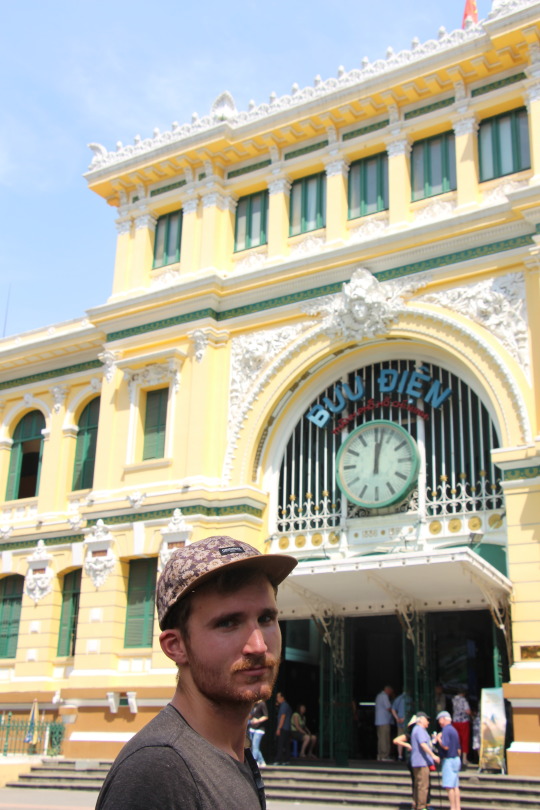
Le lendemain matin, nous attaquons la visite de la ville par le musée de la guerre. Un musée très intéressant retraçant les différentes étapes de la guerre, mais avec des images très prenantes. Après, nous allons voir la cathédrale et le fameux post office avant de nous perdre dans les petites rues et de manger dans un boui-boui local le soir, avant de prendre notre bus pour Dalat.
5h30, “DAAAAAAAAALLLLLLAAAAAATTTTTT” nous crie le chauffeur ... mais nous devions pas arriver à 7h ? Si si, mais ici on s’en fout ! Ce sont des fous furieux du volant et même si on arrive en avance, on te dit de sortir et de te demerder...
Nous arrivons 45 minutes plus tard à notre auberge de jeunesse, où bien évidement tout le monde dort. On profite alors d’un magnifique lever de soleil sur les montagnes juste en face de notre auberge.
Nous partons faire la visite de la ville de Dalat, dont le fameux marché de Dalat. Nous y achetons quelques spécialités pour le déjeuner, dont du Tofu que nous prenons pour du fromage... On peut vous dire que le Tofu frais, ce n’est pas top.
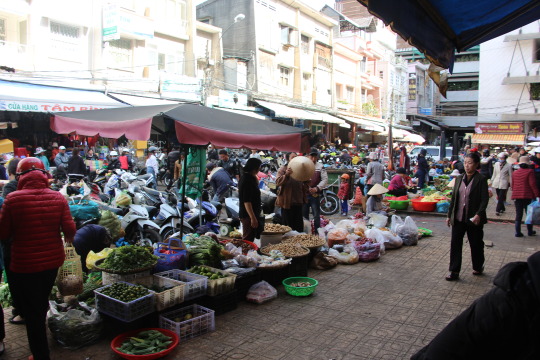

Le lendemain matin, nous enfourchons un nouvel acolyte, qu’on appelle Alfred. Avec lui, nous partons à la découverte de la campagne de Dalat, dont l’Elephant Waterfall, les plantations de cafés, la Pongour Waterfall et la pagode Lin Phuoc ! Une super journée !
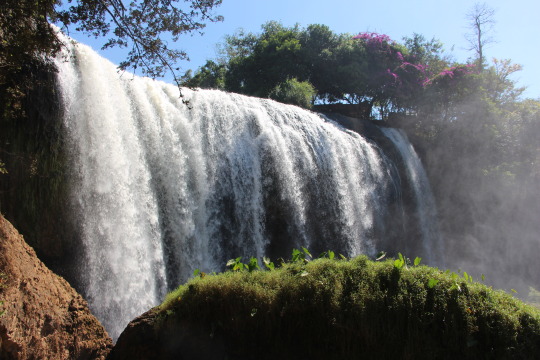
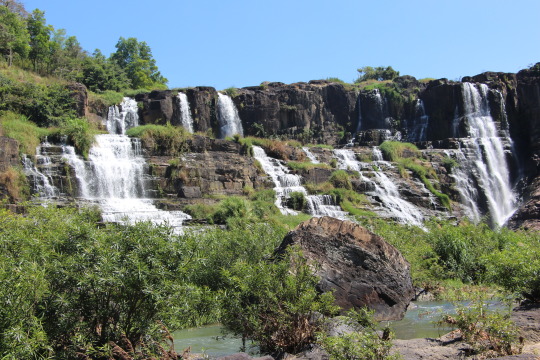
Le jour d’après, nous nous baladons le matin dans la ville dont certains quartiers sont inspirés de Deauville. Les français avait construit cette ville comme une station balnéaire pour les expatriés, comme la ville de Sapa dont nous parlerons plus tard.
Nous prenons un bus en fin d’après-midi pour Danang. Et c’est parti pour 14h de bus à l’arrière et en hauteur.
En arrivant à 7h du matin, nous sautons directement dans un bus local pour Hoi An et encore 1h30 de bus.
Et nous arrivons enfin à Hoi An. Nous commençons par traverser la ville à pied afin de rejoindre notre hébergement qui se trouve de l’autre côté de la ville par rapport à la station de bus. Sinon ce ne serait pas drôle. Arrivés sur place, l’endroit est paisible et il y a disposition des vélos. Nous prenons deux bicyclettes et c’est parti pour découvrir les alentours dont la plage. Dès le midi, nous nous arrêtons dans un petit restaurant afin de goûter la spécialité locale, le Cao Lau ( c’est un plat avec des nouilles très épaisses, des légumes, de la viande, des chips de mais et un peu de bouillon). Et bah on a trouvé ça... excellent !
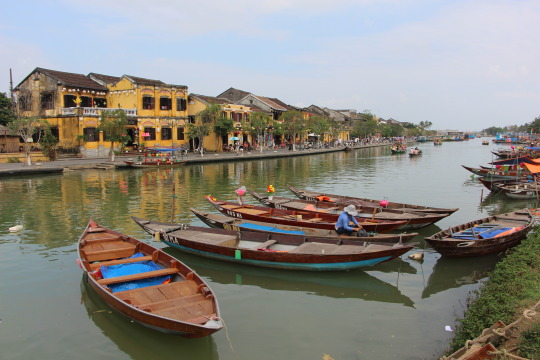
Nous marchons sur la plage l’après-midi, puis nous filons voir les rizières. Le soir, nous retournons en ville, avant de manger d’autres spécialités locales comme les white roses. Au fur et à mesure que la nuit tombe, les lanternes dans la ville s’allument et illuminent celle-ci. Tout simplement magique.
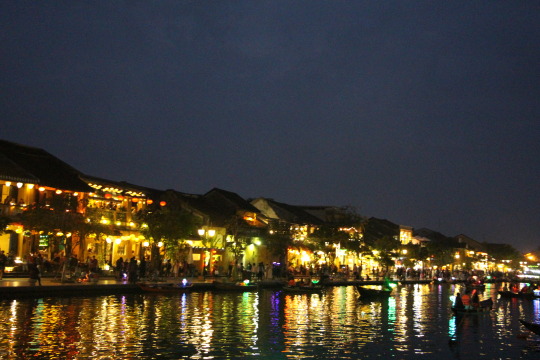
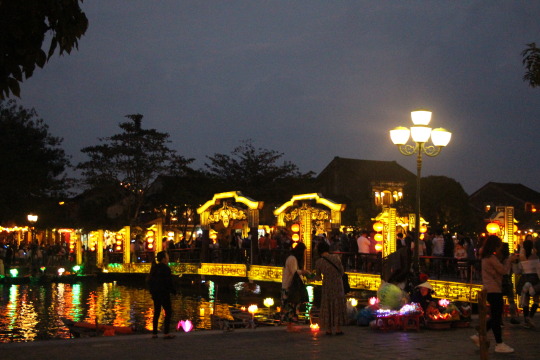
Le lendemain, nous continuons notre balade en vélo à travers les rizières sur les îles aux alentours et dans la ville. Le soir, nous profitons une nouvelle fois de l’ambiance de la ville. Le lendemain, nous devons nous lever tôt pour un cours de cuisine.
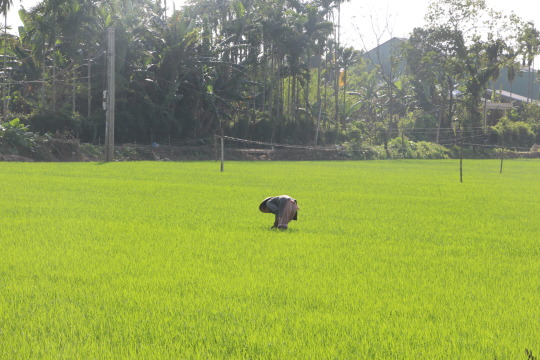
Et c’est parti pour 2h30 de cuisine vietnamienne, avec un cours privatif ! On apprend alors à faire, une papaya salad, des wontons, du Cào Lau frie, et nems. Il ne faut pas uniquement les cuisiner, il faut également les manger ! Un vrai festin ! (c’est Fabien qui est content ! Merci encore Eric et Nelly pour ce cadeau ! )
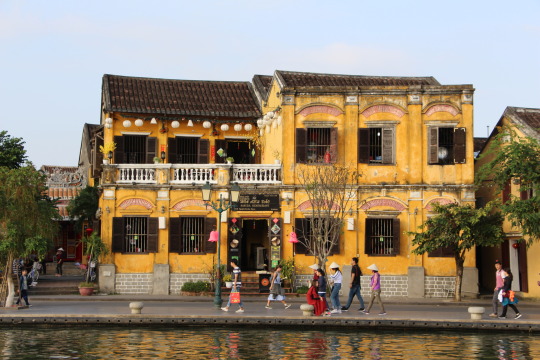
Après que nous ayons bien rempli notre ventre, nous partons voir une exposition de l’artiste Rehann qui met en avant les différentes ethnies du Vietnam à travers sa photographie. Une très belle exposition !
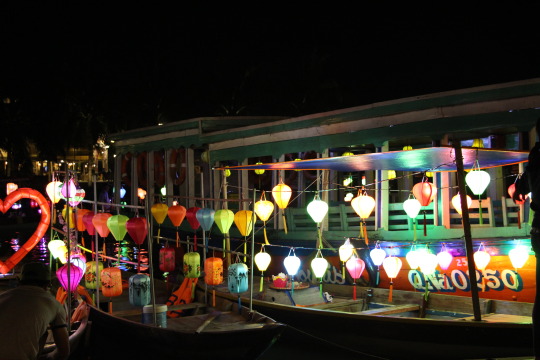
Nous prenons de nouveau un bus le lendemain matin pour la ville de Hué et sa fameuse citadelle.
Nous arrivons sur place en fin de matinée, et nous commençons directement notre visite de la vieille ville par la dégustation de plat locaux, une nouvelle fois, dont le Bun Bo Hué !
Et le lendemain matin, nous partons très tôt découvrir la fameuse citadelle, où nous y restons quasiment 4 heures afin de voir tous les recoins. Un endroit incroyable !
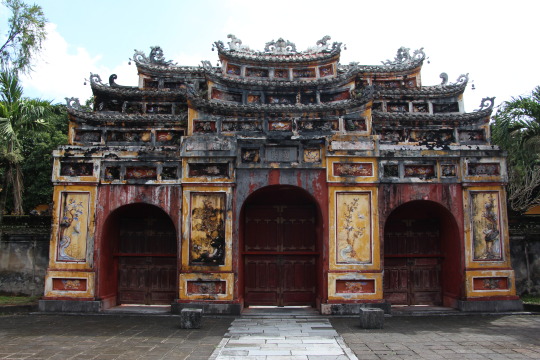
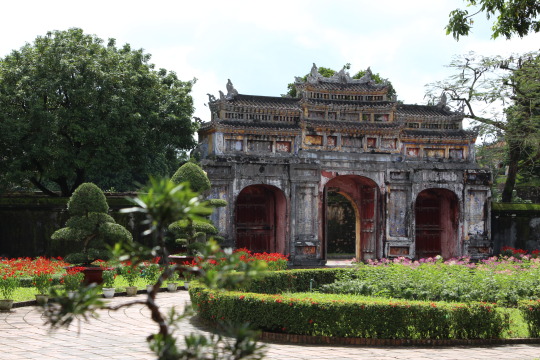
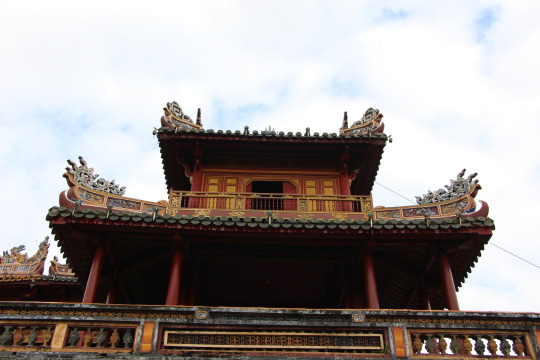
Nous prenons dans l’après-midi, une nouvelle fois, un bus pour la baie d’Halong terrestre et la ville de Ninh Binh.
On y arrive à 4h du matin. Le bus nous arrête dans une rue en plein de milieu de la ville... pas très pratique pour trouver un moyen de se rendre à notre hébergement qui est situé à plus de 6km...
Nous arrivons à nous y rendre et prenons quelques heures de repos dans un dortoir.
Nous partons en fin de matinée pour Trang An et sa fameuse balade en bateau de 3 heures à travers les montagnes karstiques. Cette balade en barque nous fait parcourir des lieux magiques dont des caves incroyables, des temples cachés sur les montagnes. Un moment incroyable.
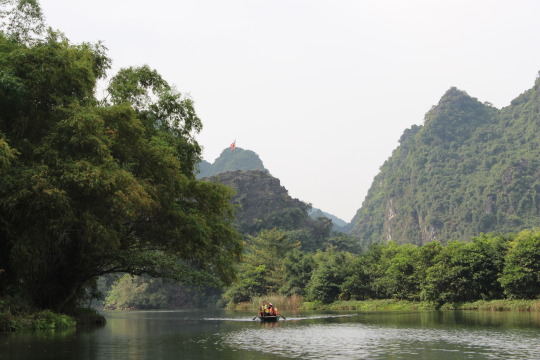
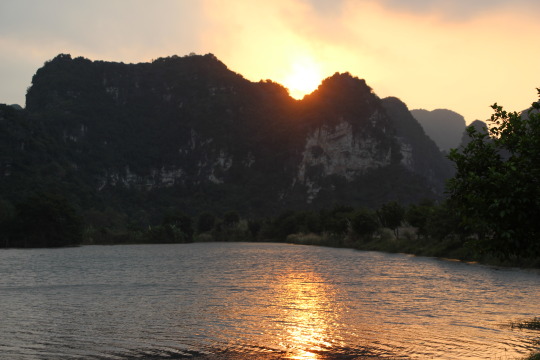
Le lendemain matin, nous enfourchons une nouvelle fois des vélos afin de parcourir les alentours de Tam Coc. C’est incroyable de se retrouver au milieu des rizières avec les montagnes nous surplombant. Cette région restera comme une des plus belles que nous ayons vu au Vietnam.
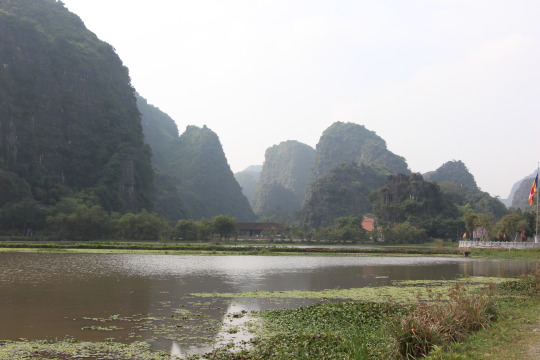
Le jour suivant, on part pour la capitale et la ville d’Hanoï ! Nous y arrivons en fin de matinée. Par chance, nous y arrivons aux alentours du Tet, le nouvel an chinois et la ville s’est alors en partie vidée de sa population. La tradition pendant le Tet, c’est que les personnes rentrent chez elle à la campagne, s’occuper de leurs ancêtres.

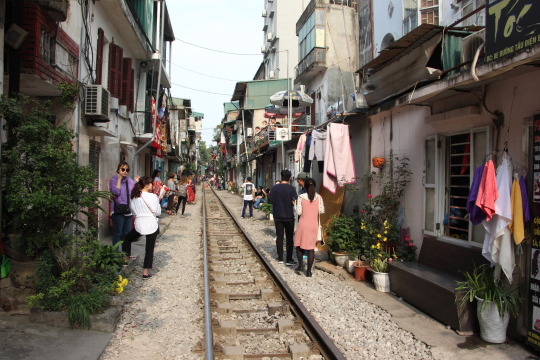
Nous profitons alors de deux jours à la capitale pour nous balader à pied. Nous visitons le mausolée d’Ho-Chi-Minh, la voie ferrée qui est dans la ville, le marché de nuit, etc.
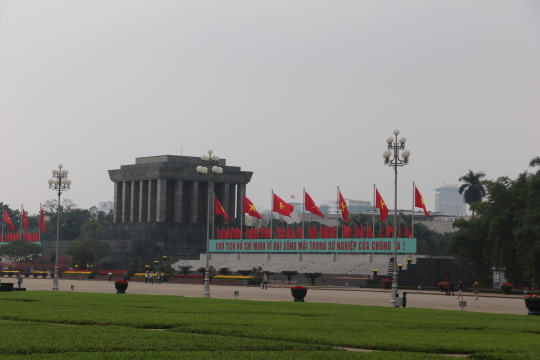
Puis après deux jours à Hanoï, nous partons tôt pour la ville de Sapa et les fameuses rizières.
Après un trajet en bus bien mouvementé, nous arrivons à la ville de Sapa en début d’après-midi. La ville ressemble alors à une ville morte, l’ensemble des magasins et des restaurants sont fermés pour le Tet, ce qui donne une sensation très bizarre.
Nous déposons nos affaires à notre hôtel et nous partons à la découverte de la ville et des alentours (proches).
Le lendemain matin, nous partons tôt faire notre trek par nous-mêmes dans les rizières et à la découverte des ethnies de la région. Un moment incroyable de bonheur, où nous sommes seuls pendant six heures dans les rizières. Nous rencontrons parfois des personnes locales et nous entamons des discussions avec eux à l’aide de nos mains. Un moment magique !
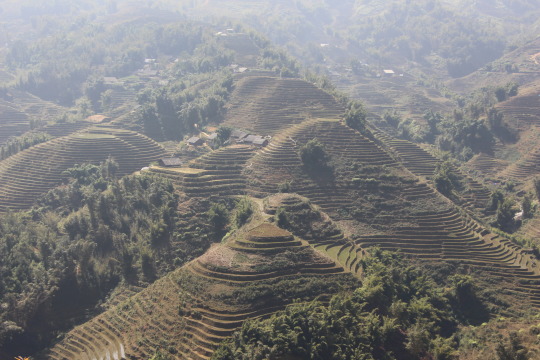

Nous finissons notre journée par la visite de la ville de Cat Cat, juste à côté de Sapa.
Le lendemain, nous essayons tant bien que mal de trouver des billets de bus pour Ha Giang, notre prochaine destination. Malheureusement, le Tet, nous empêche de partir avant deux jours encore. Nous restons donc bloqués ici et nous entamons de nouvelles marches aux alentours.
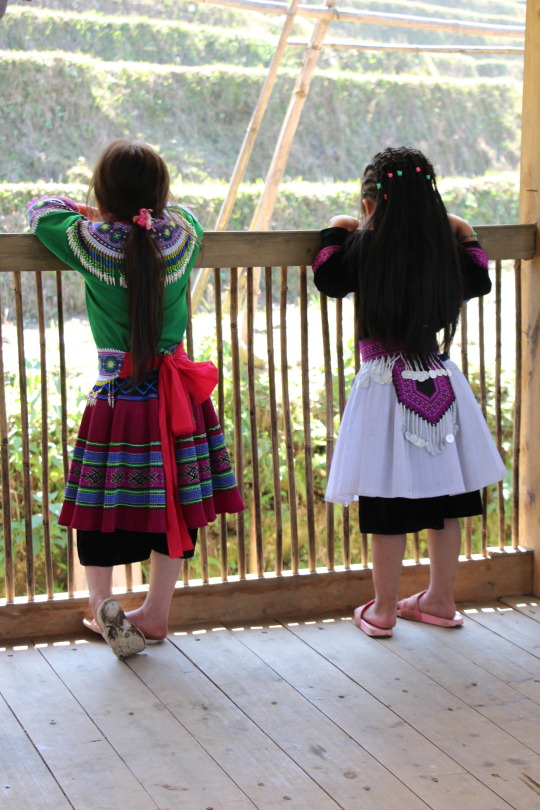
Après donc trois jours de marche dans les rizières, nous montons dans un bus direction Ha Giang. Le bus est fait pour 20 personnes, mais nous finissons à 32 dans celui-ci ! Et c’est parti pour 8 heures de routes !
Encore une expérience ce bus,... on vous passe les détails, sauf que la pause pipi s’est faite dans une rizière. Très pratique pour l’intimité...
Nous voilà arrivés après plus de 8 heures de bus à Ha Giang, ville de départ de la loop pour la Grand Nord.
Nous profitons de la soirée à Ha Giang pour partager un bon repas avec d’autres personnes qui vont faire la boucle. Nous nous levons tôt le lendemain matin afin de partir le plus vite possible sur les routes incroyables du Nord du Vietnam.
Et c’est parti pour les trois jours les plus impressionnants de notre tour du Vietnam. Pour notre première journée, nous faisons 200 kilomètres de routes de montagnes en moto. Nous passons à travers des paysages magnifiques et nous arrivons même à mettre les pieds en Chine ! Nous finissons notre journée au point le plus au nord du pays. (Nos portables ont même cru que nous étions en Chine... les bleus quoi...). La route est vraiment incroyable et au cours de ces trois jours, nous avons la chance de voir les ethnies de sortie pour le Tet avec leurs costumes traditionnels.

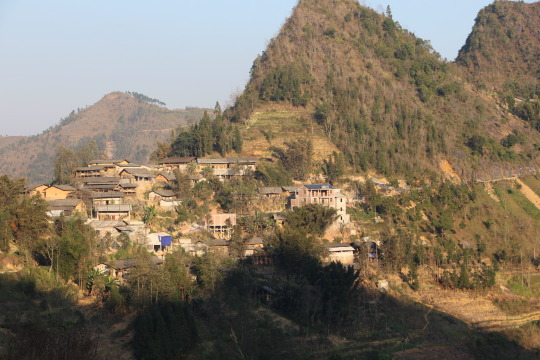

Le deuxième jour, nous prenons la route un peu plus tard et nous effectuons les 100 km entre Dong Van et Yen Minh, en passant par Meo Vac. Certainement, un des plus beaux passages de la boucle. Nous prenons une petite route pour finir la journée et nous sommes alors les seuls occidentaux qui traversons les petits villages. On finit la journée à Yen Minh et Fabien ira même faire un foot avec les petits locaux.
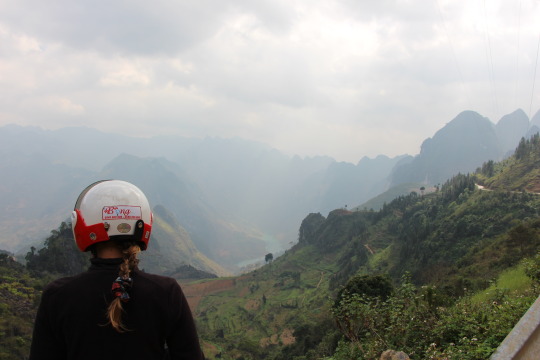
Pour le troisième jour, nous reprenons la route en fin de matinée, direction Ha Giang. Nous prenons notre temps et admirons les magnifiques paysages par lesquels nous passons. Cette boucle restera comme un des meilleurs moments de notre voyage au Vietnam.
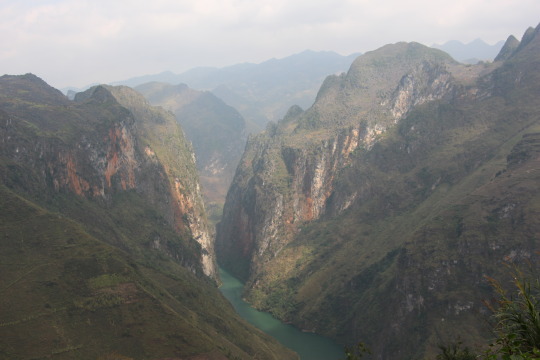
Nous revenons sur Hanoï, en bus de nuit. Nous arrivons à 2h30 du matin, mais par chance, le chauffeur nous y laisse dormir jusqu’à 7h ! Ouf !
Nous nous baladons de nouveaux dans Hanoï avant de partir le lendemain pour une croisière sur la baie d’Halong.
Et c’est parti pour deux jours sur la baie d’Halong. Un endroit incroyable, même si la présence de autant de bateaux de touristes gâchent un petit peu certains moments, les paysages sont incroyables !
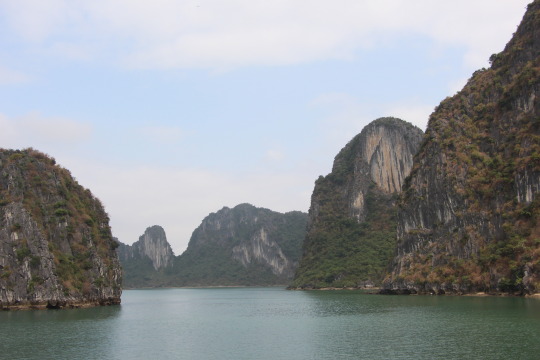
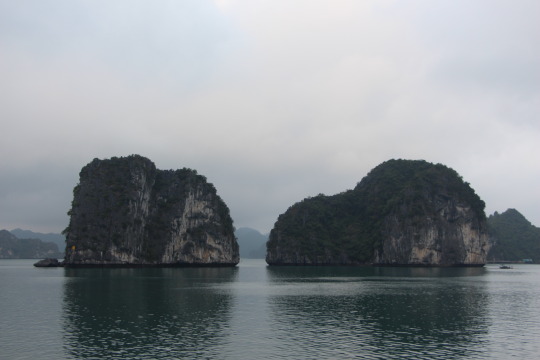
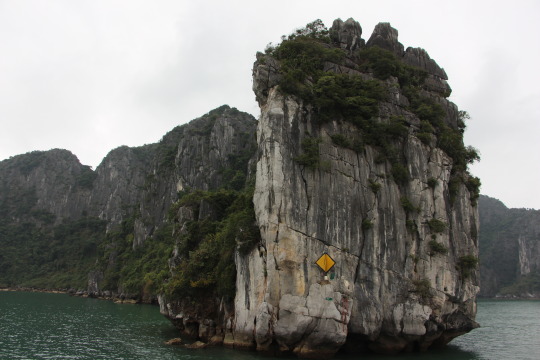
Nous visitons une immense cave, nous montons à un point de vue incroyable sur la baie, nous apprenons à faire des rouleaux de printemps, etc. Un moment super sympa ! (Merci Eric et Nelly (Papou et Mamouna) pour ce super cadeau !)
Nous revenons sur Hanoï pour notre dernier jour au Vietnam et en Asie du Sud-Est avant de prendre notre avion pour la Japon !
Voilà, notre 5ème pays en Asie, c’est fini !
On se retrouve au Japon !
Les P’tits Français en Vadrouille
0 notes
Link
#business for rent#business buillding#business building for rent#office building#office building for rent#business building for rent in Phnom Penh#business building for rent in Cambodia#office building for rent in Phnom Penh#office building for rent in Cambodia
0 notes
Photo










More temples.... we also visited Phnom Penh and sihanoukville while in Cambodia, some niceish places but pretty quiet. We had to bribe a police officer because we didn't have the correct license for the scooter we rented... no pictures of that as he wasn't to keen on selfies.
2 notes
·
View notes